"This is far more stressful than COVID."
Consumer founders on trade policy that is less reliable than the fucking AccuWeather App.
Hello everyone. Hope you had a good weekend.
Today’s letter is free, and includes: consumer founders on their game plans for Trump’s tariffs, The Row wants you to buy their home decor, The New York Times know you love reading about consumerism (so they’re hiring a retail reporter), summer internships for slackers, Minecraft is causing food fights in movie theaters, and Sofia Coppola at Metrograph.
April 2nd was “Liberation Day.” The Trump administration launched sweeping tariffs that left few industries or countries untouched. Since then, the S&P 500 has put up one of its biggest three-day streaks of losses in decades, and anyone who imports stuff has been flung into a state of panic and uncertainty. No one — business owners, pundits, America’s trading partners, the Trump admin’s various spokespeople— seems to know what’s going on.
It’s easy to assume tariffs’ impact heavy industry, or industries of some “national importance”: steel, cars, microchips, and easy to assume that’s where it ends. But that’s not the case here. These tariffs are having an immediate (like right now) impact on the corner of industries where we spend a lot of time at Feed Me — apparel, CPG, and other consumer startups. Even for categories where I thought, “Well surely that supply chain is domestic” like food, skincare, or some supplements, Nope! They rely on imports in some way. When I was reporting for my Shoppy Shop piece for New York magazine, gave me a quote that I think about a lot: “We need a new term for ‘internet-based small businesses that still use global supply infrastructure. We know these minimalist-ish generic aesthetics are not connected to any true local origin, but we see them as indicative of some kind of authenticity. My current thought is that they don’t feel local to a place, but instead they feel local to the internet, which is, after all, where we all live.” Even businesses of a small and “independent” profile are shockingly, deeply tapped into global supply chains. These new tariffs will hit them too.
There’s been a lot of talk about “business uncertainty,” and sometimes it can sound like a boogeyman to keep the government from trying things or doing things. I wanted to hear from real, live business owners, who make finished products that we interact with every day (not cold rolled steel), about how they’re responding to the tariffs. So I sent out a bat signal, and shared the conversations I had in today’s letter.
Some standout learnings from the below conversations:
🍫 Raaka Chocolate makes chocolate in Brooklyn, but ingredients like coconut and packaging like foil and cardboard are imported.
🐄 Beny Yogurt is entirely U.S.-produced, but “nervous about the consumer” as inflation drives prices up.
🔥 Dame’s vibrators (most vibrators) are made in China. Their founder told me, “I’ve learned that stability is an illusion—that groundlessness, to borrow a Buddhist concept, is actually the default state.”
💍 Presley Oldham had his entire Paris Market season wiped out due to international buyers backing off because of U.S. tariffs.
🥃 Faccia Brutto’s spirits are made in Brooklyn, but some of their botanicals, bottles, and caps are from overseas. On top of the tariff news, they’re in an industry that’s already facing serious challenges from declines in drinking habits.
How much of your product is made overseas (and where), and how nervous are you right now?
“Our two best-selling products—the Loftie Clock and Loftie Lamp—are made in China. This is far more stressful than COVID. I’ve been waking up in the middle of the night and scribbling notes to myself. I am reading every article and consumed thinking through all of the changes we have to make. I’m reminded of the line from The Leopard: “For things to remain the same, everything must change.” I’d rather be spending our time innovating on our products—but instead, we’re being forced to rethink the fundamentals of our business just to stay in business.” - Matthew Hassett, founder of Loftie
“100% of our production is based in the US (we make probiotic organic Greek yogurt). We still will likely see impacts to our product but we are more insulated than other CPG brands - dairy is domestic, cattle feed is domestic, etc. The biggest nerves for all of us are around the impact on the consumer as prices rise.” - Kiki Couchman, co-founder of Beny Yogurt
“Approximately half of our products are sourced from China. While we anticipated some impact, we’ve been proactively preparing for the worst-case scenario by negotiating with suppliers and reducing operational costs. However, the 54% tariff announced last week was far beyond our expectations— we were initially expecting just the 20% increase.” - Anonymous wellness founder
“How can you plan with economic and trade policy less reliable than the fucking AccuWeather App?”
“In the beauty world, essentially all glass and plastic packaging comes from Asia. Sometimes glass comes from Mexico or Europe but either way, usually not domestic so there are huge implications on packaging costs increasing dramatically. For US-based brands, the formula is primarily produced in the US with some exceptions for Italy, Canada and Korea. Everyone is scrambling to try to find domestic sources but babe, those factories closed long ago.” - Anonymous beauty consultant
“All of our product is made in the U.S., however many of our ingredients and packaging materials come from overseas. Coconut products are getting hit pretty hard given that they're from some of the countries with the largest tariffs (Vietnam, Sri Lanka, Indonesia). Things we have to use on a daily basis, foil, cardboard etc.. are also getting hit pretty hard. Pretty nervous about our overall margin at the moment.” - Nate Hodge, co-founder of Raaka Chocolate
“Most of our products — especially our vibrators — are made in China. Even the ones we manufacture here, like our lube and massage candles, still have components from overseas. Am I nervous? I’ve learned that stability is an illusion—that groundlessness, to borrow a Buddhist concept, is actually the default state. Being present, nimble, and clear helps. So I'm not nervous, but I'm aware that we are about to go on a crazy ride, and I will have to make many decisions that I'd prefer not to have to make.” - Alexandra Fine, founder of Dame
“Cheese and the quality of the cheese is my most important ingredient to make the French Cheese Puffs and cheese is my most expensive ingredient normally though now eggs, the other major ingredient, are a very close second due to the supply issues from avian flu. My overall COGs will increase by 2% with the new tariffs. If you add in the 100% increase for the cost of eggs and now the tariffs, my COGs have increased by 5%.” - Kris Middleton, founder and CEO of Bougie Gougies
“We make peanut butter from Argentinian peanuts and Patagonian sea salt. We produce our peanut butter both in the US and in Argentina, but either way we will now pay 10% tariffs on importing both the finished goods or the raw ingredients. Since our entire brand is based on these special peanuts, there's no way to pivot to another option ingredient wise. The bigger issue is we've been working on big jar innovation behind the scenes for the last year. It's been a huge investment for us and with production and retailer timelines, we've already produced and paid for 80k custom jars in China that haven't been imported to the US yet. We thought we'd be able to import from China to Argentina to mitigate the extra spend but our producer in Argentina isn't able to fill the new packaging so we're going to get hit on both ends, the product from Argentina and the packaging from China. These jars are slated to hit major retailer shelves in May and June and we already have agreed upon prices with said distributors and retailers. The new cumulative tariffs on Chinese goods will hit these jars at 60-80%, increasing our overall COGs by 30%, which will make us lose money on every jar at these already-agreed-upon-prices.” - Lucy Dana, founder and CEO of One Trick Pony (peanut butter)
“We make all of our products in Brooklyn, but we do source our bottles, caps, and botanicals from overseas. We’ve already seen the cost of botanicals rise every year since we’ve been in business, which was likely continue to happen regardless. Since we are in the spirits business, margins are flexible and able to withstand some hits, but depending on how severe those hits get, we may need to adjust price prices for the first time since we went into business five years ago. And in an industry that’s already facing serious challenges from declines in drinking habits, returns to post-covid norms of consumption, etc… our consumers would not be thrilled. Considering that imported products are going to cost more, we are going to work even harder to keep our prices as low as possible to offer people an affordable domestic option.” - Patrick Miller, founder of Faccia Brutto
“The biggest overseas component of our product is the custom glass bottle that houses our nonalcoholic spirit, which is manufactured in Asia. We spent years exploring the best solution for our unique packaging needs. While our strong preference has always been to source and produce everything in the U.S., the reality is that domestic options for custom glass bottles are extremely limited and often cost-prohibitive. We also explored manufacturing in Mexico, but faced similar challenges with both availability and cost. We ultimately partnered with a U.S.-based company to design and manage production of our bottles, but their manufacturing facilities are located in Asia. As a startup in a high-growth phase, this situation is definitely nerve-racking. We’re working hard to keep up with demand while navigating rising costs, supply chain volatility, and a more cautious consumer landscape. In many ways, it’s the best of times and the worst of times.” - David Fudge, founder of Aplos
“100% of our product is made in Mexico. Mezcal is part of the USCMA so it's still not 100% whether for anyone whether we will be taxed at 0% or 25%. It's been a rollercoaster.” - Rafa Shin, founder of Agua Mágica Mezcal
“All of my work is crafted in the US, but my materials such as freshwater pearls and handmade glass come from Japan, China and Italy. These tariffs will directly affect the cost of raw goods that my suppliers are paying, but that won’t affect me until I am buying for my new collections in 6 months to a year. This is one of those delayed effects that we are going to see long term damage from…This will directly affect my margins and I’m not fully sure how to combat that at this exact moment. I’ve already had to raise my prices over the last year because raw goods have already been increasing without the impact of these new tariffs. I don’t want to price out the customers who have been with me from the beginning, so I think I will just have to further diversify the cost of my products — creating lower cost pieces as well as higher priced pieces.” - Presley Oldham, founder of Presley Oldham Jewelry
What’s your backup plan if tariffs hit your margins? Raise prices? Shrink your packaging?
“We will have to raise our prices, which is especially painful for orders we have already taken at the wholesale level for Fall 2025. We priced and sold our pieces to other retailers with the tariffs that were in place at the time, in February, for orders that will ship beginning in August. We can’t change the prices on them now, though we will likely make a much smaller profit margin on our wholesale prices- if we make any profit at all on those orders. “ - Nikki Chasin, founder of women’s clothing brand Nikki Chasin
“Price increases are inevitable. I have brands on the cusp of launching new products who are upping the SRP proactively days/weeks before launching. No one knows what’s going to happen but the brands don’t want to be on the losing end of the guessing game. I do have some brands cutting out packaging ‘frills’ like inserts and liners but spoiler alert, they were doing it before tariffs because of private equity pressure and will likely blame it on the tariffs regardless. VCs know how to suck the life out of a brand.” - Anonymous beauty consultant
“In the short term, we’re doing everything we can to streamline operations and absorb costs internally, rather than pass them on to our customers. One of our core value propositions at Juliet is to offer great value for money—even a 10% price increase feels at odds with our brand promise.” - Allison Luvera, Co-founder of Juliet Wine
“We are looking at some creative alternatives to the french cheeses we import as LTOs that can help offset some costs without sacrificing quality, ie: testing out a limited edition flavor for summer like Hatch Chile Cheddar so we can use cheese from the US but for our flagship flavors we just can't source cheeses of equal quality and authenticity here.” - Kris Middleton
How would your customers react if your product suddenly cost 15% more?
“We make technical ski wear and outdoor apparel. We have built our brand on being a more approachably-priced option in the fashion-forward space (in comparison to other ski brands like Moncler, Bogner, Perfect Moment, Arc’teryx, etc.). We feel strongly about maintaining our positioning as a high-quality, fashion-forward, and approachably priced brand, however, the tariffs will make it extremely difficult to not bump our prices up to a place that will unfortunately make the products slightly less accessible for a more mid-market shopper.” - Ariana Ferwerda, co-founder and CEO of Halfdays
“We are fully committed to protecting our relationship with our consumers and do not want to alienate them. As we have done in recent years, we plan to mitigate the impact of any price increases by gradually implementing them or only doing them on certain products, rather than imposing steep hikes all at once. However, these increases are unavoidable if we are to avoid the risk of bankruptcy in the long term. This has been the same reality of inflation in the past few years.” - Anonymous wellness founder
“For most of our clients, a 15% price raise in either China or the US pushes the product into a different level of consideration. In China, a 15% price raise might make a product as expensive as a luxury option. From a brand perspective, how do you react to that given the fact that there is no certainty tariffs stay in place. Do you premiumize, which costs marketing dollars, but end up burning money when all of this goes away? It’s the global uncertainty that makes all of this so crippling. You could make short term decisions that eviscerate your business over the long haul. Or, you could be slow to react and cripple your business. You need to work through a bunch of different scenarios so that you're not left flailing around.” - Jonathan Heeter, Managing Partner of Black Pine, an Asia-US focused cross-border marketing agency
“We will continue to communicate with our customers via socials/building in public channel as we navigate through this. This is a very uncertain time for everyone, and continuing an open communication channel as we think through the implications is paramount for our brand. Given we are still pre-launch, we aren't as concerned with customer retention, rather we are much more concerned with incentivizing trial of new products. We will be coming to market during very uncertain times and the biggest concern is whether customers are willing to try something new when they are already being stretched at the grocery store.” - Kiki Couchman
“Probably replaced with other products (either bad quality mezcal or tequila). Mezcal is particularly price sensitive since most of it is consumed in cocktails and since Tequila is much cheaper to produce and has loads of unsold inventory, we are seeing heavy discounting across the board.” - Rafa Shin
“I think our DTC customers would understand. They, for the most part, want to see us succeed as a business. We've built a lot of positive equity with them over the years. Still, I think luxury goods in general are going to take a hit for the foreseeable future, and craft chocolate certainly fits in that category as people struggle with the cost of everyday essentials. I'm concerned for some of the smaller independent stores that we service, that cary a lot of imported specialty goods. Those businesses are going to have a hard time, and those businesses have been the backbone of our business.” - Nate Hodge
Have you started comparing notes with other founders?
“Yes — understandably, everyone is freaking out a bit. Even brands that do all of their cutting and sewing in the U.S. buy materials from overseas, so it’s a problem for pretty much every American clothing brand.” - Nikki Chasin
“I'm on a pretty epic group chat with a bunch of other New York City beauty founders and everyone’s feeling stressed for sure.” - Sofie Pavitt, founder of Sofie Pavitt
“I’m part of several Slack groups with hundreds of other founders across industries, and this is the number one topic right now. For brands that rely more heavily on overseas manufacturing, the impact could be catastrophic. There’s definitely a lot of mutual support in the founder community, but when your margins are on the line, it starts to feel like survival mode for many.” - David Fudge
“Given we are still pre-launch, we aren't as concerned with customer retention, rather we are much more concerned with incentivizing trial of new products. We will be coming to market during very uncertain times and the biggest concern is whether customers are willing to try something new when they are already being stretched at the grocery store.”
“I think all we have at this moment is community — we have to rely on other designers and see how we can all come out better on the other side. I think this new wave of tariffs is hitting people in a different way, and it’s starting to become real very quickly. I’ve definitely been wanting to speak about these impacts, and be open about it within fashion and the community. We’ve never been in this type of situation before, and it is really dire. We have to be inventive about how to weather this storm. I know that I will get through this, but it’s really heavy mentally to feel like a lot of this is so out of your hands. I’m trying to ground myself in what I control, which ultimately comes back to refining my production and maybe slimming down some of the plans I had for this year. These tariffs are not going away, and the impact is going to be felt in waves. I really think independent brands will be the first to feel this, and heavily. We have to lean on each other, and reinforce the backbone of the companies we’ve built.” - Presley Oldham
Do you think this is all going to go away before these tariffs are actually implemented?
“The tariff already coming in from China is 10% even if it’s negotiated it’ll probably come in higher than existing so even so there’ll be a pinch coming for brands. and indie brands will feel it harder than larger ones.” - Sofie Pavitt
“This question points out the most insidious part of this mess. How can you plan with economic and trade policy less reliable than the fucking AccuWeather App? You need multiple scenarios planned out, and you need to be both strategic and reactive.” - Jonathan Heeter
Do you have any intention to reshore production/start producing in the USA?
“I truly wish we could make these products in the United States. It would lower freight costs, simplify our operations, and create more American jobs. But the infrastructure just doesn’t exist in the U.S.—not for consumer electronics. The idea that a small business like ours could reshore production right now is just not grounded in reality.” - Matthew Hassett
“I'm on a pretty epic group chat with a bunch of other New York City beauty founders and everyone’s feeling stressed for sure.”
“No — we produce what we can in the U.S., but the items we produce overseas require special skills and materials. Even if there was the skill to make some of our embroidered and knit pieces in the U.S., we’d still be purchasing materials overseas and paying tariffs on them. The available yarns and textiles made here are limited in variety and very costly. We have strong, established relationships with our overseas partners, some for 7+ years. I wouldn’t want to rebuild our supply chains in such an uncertain climate. We don’t have the skilled workers here to rebuild the garment industry, and it’s highly unlikely that we ever will.” - Nikki Chasin
“There’s literally no vendor in the US who could make our components. They literally don’t have anyone who could make them.” - Sofie Pavitt
“Everyone we talk to wants to manufacture in the US but it’s a very long process, and even if they manufacture here, components will remain a massive lever for pricing pressure. Not to mention, are salaries going to go up across the board so that broad sections of the US consumer market can afford a 3500 dollar iPhone or 120 dollar Walmart t-shirt? There's no industrial policy to compliment the tariffs so there's no real way to assess the long-term impact on demand. If you're a Canadian or European brand, maybe it makes more sense to focus on China where demand is both more predictable and segmentable given the scope of the market.” - Jonathan Heeter
“There are a few collections that we could move to LA (knitwear, cut & sew, etc.) but unfortunately the USA does not have the technical production capability that Asia has. It just simply doesn’t exist here. No one does outerwear or technical ski wear production to the same level of quality and fit standards that we’re able to achieve in Vietnam.” - Ariana Ferwerda
Any additional thoughts you have in regards to this conversation.
“This is my last anecdote -- I have a friend who is a PhD at Harvard and had her scientific research grant canceled, along with the rest of her cohort doing medical research (cancer, Alzheimer's, etc). All of these changes are real and happening. It's unprecedented and terrifying.” - Anonymous wellness founder
“For our family-run CPG business: the cost of raw materials and packaging will go up significantly (34% and 50%+ respectively); no US-made comps here unless we can hit their minimums (and we can’t). Co-manufacturer is in the US but they source their raw materials from US suppliers who, you guessed it, import almost everything. Cost will be passed on to the customer almost immediately as we have materials arriving stateside in the next 1-2 months and haven’t planned for the extra production costs. If customers aren’t willing to pay, it’ll wipe out our biz.” - Anonymous CPG founder
“Almost every American brand is either a global brand or wants to be. The impact of these tariffs, both in terms of the economic response from China, the EU and others, as well as the loss of American prestige, is causing incalculable damage. American brands typically sell some aspect of the American lifestyle. Ralph Lauren is a great example of that. What person living in Shanghai or Berlin wants other people to think they're representing the American Dream in 2025? The American consumer base is massive but it can’t support the valuations and aspirations of American brands by itself. A drop in Chinese demand could cripple global US brands like Nike, who need the sales and the perception of growth in China to support their stock prices. This isn't a price up, price down scenario. It's a global branding crisis for America and American brands.” - Jonathan Heeter
“ I literally had stores from Canada and Mexico say to me that they loved my work, but couldn’t even speak to me right now because of the US tariffs and state of the country.”
“Small businesses and consumer startups are becoming collateral damage in a global trade war. While large corporations have the leverage to negotiate pricing and the resources to weather the storm, small businesses simply don’t. Many of us believe in the idea of manufacturing in the U.S., but we’re not the ones with the resources to make that change. So when the administration talks about short-term pain for long-term gain, unfortunately I think it’s going to be small businesses and consumers who bear the brunt of that pain” - Allison Luvera
“I’m a jewelry designer based in Hudson NY. I’ve had the company for 5 years this May, and last year was objectively our best year in terms of profits (doubled our profits for 2024) and public recognition (I was a finalist for the CFDA Vogue Fashion Fund/nominated for CFDA Award). Coming off of all of that, I was really excited and hopeful for 2025. I decided to do Paris Market for the first time in March, which was just horrible timing with these tariffs. At that point, a lot of it still felt imaginary and we didn’t know how it would affect us individually or as a company. But during market, I literally had stores from Canada and Mexico say to me that they loved my work, but couldn’t even speak to me right now because of the US tariffs and state of the country. All of my other orders I had placed during market (from stores in the UK and France) have now canceled because of the newer tariffs, and my US stores are also not really reordering (because they already placed orders with European big brands that will now have additional costs due to the tariffs). That is a huge chunk of my business and revenue, and we as independent designers will be bearing the brunt of this. Stores are already giving preference to larger name brands, and now they have to devote more money to them with these additional tariffs.” - Presley Oldham
I know there are a few thousand college students who read Feed Me. While researching for the letter over the past few weeks, I came upon some exciting internships that I’d be applying to if I was in college and didn’t have a summer game plan lined up yet. Considering it’s April 7th… these ones are for SLACKERS.
Bloomberg Tokyo news internship: Enter your Girls S5E3 era and head to Tokyo for a hands-on reporting internship with Bloomberg. It’s paid, and you have to be able to speak some Japanese.
Hermes digital strategy internship: I didn’t know that Hermès internship program was called' "Generation H.” This specific internship runs from July 14th, 2025 - December 26th, and is based in New York. Full-time internships require 37.5 hours per week, so I hope you can take night classes!
New York Yankees internship: This one is fun because it lets applicants rate their top departments of interest (social media, ticket sales, legal). Salary is solid ($17.50/hour), commute is a little rough.
The New York Times is hiring a retail reporter. This is the latest in a series of media jobs focused on retail reporters – last week I wrote about Bloomberg’s latest job opening for a CPG reporter. I’ve always believed that you can learn the most about a subculture by observing how they spend money, it’s the mantra Feed Me was built upon. I’m excited to see how The New York Times defines their own coverage of founder drama, fundraising, and the culture of consumerism.
Alix Earle is obviously about to launch a skincare partnership. She’s been spending a significant amount of time on her social channels showing her skincare journey, including New York-based doctors (perhaps co-founders…) she’s seeing and tracking progress. In her caption last night, she said “will keep u guys posted on what I’m using on my skin to clear it :)” which makes me think we’re about to get an Earle-approved line.
If you can’t go to Palm Heights, you can at least recreate their Balance smoothie.
Paige DeSorbo wrote a self-help book with podcast co-host Hannah Berner. Surprised this story doesn’t mention the rumored $2mm raise for her clothing brand that my friends won’t stop texting me about. I like Paige, maybe she’ll participate in the Feed Me Hamptons book club.
The Row enters the home department. Prices for their new handwoven blankets aren’t listed online, but I took one for the team and inquired about the cost (always a bad sign for wallets when this is how you find out).
Metrograph has programmed a Welcome to Suburbia series this month, screening movies like Thirteen and The Virgin Suicides.
Guys are wearing jeans to the gym. One guy said he only has four pairs of pants and his jeans go from the gym, to dinner, to his bartending job. I aspire to this type of minimalism.
The Minecraft Movie is a huge hit, it’s the highest grossing launch since Deadpool vs. Wolverine last year. It also beat the record for best video game adaptation opening, and it’s reportedly causing popcorn food fights in the theaters. On one hand, nightmare to clean up. On the other, keeping our theaters alive.
Forget the stock market, it’s a big day for budget airlines corporate moves.
A high-end sex work operation catering to Boston’s elites charged up to $600 an hour before federal prosecutors brought it down. “They chose these locations because they were trying to attract rich and powerful men who wanted to buy sex.”
New York Magazine’s latest cover took 11 days to shoot. Last night, Oliver Darcy reported that the issue, “brought in the highest volume of theater and culture advertising in recent years.” That’s what we call show business.


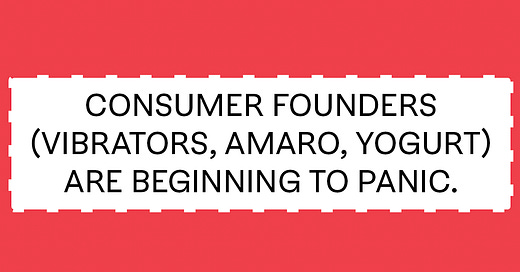




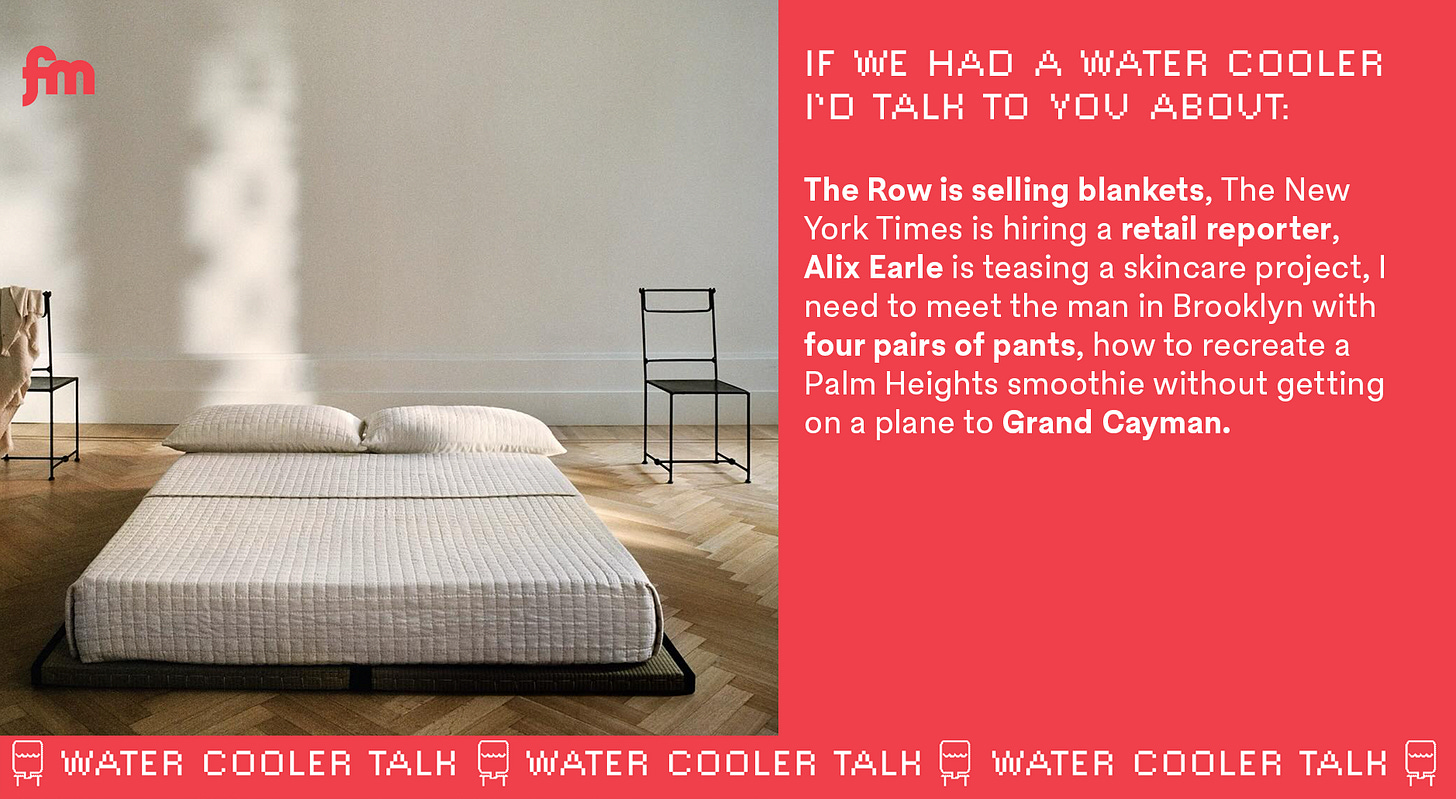






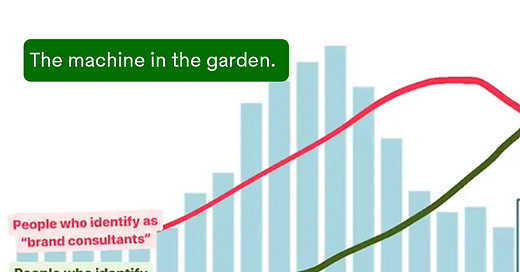

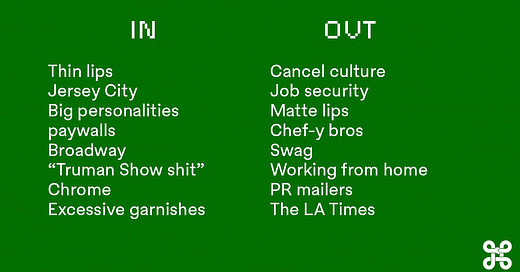

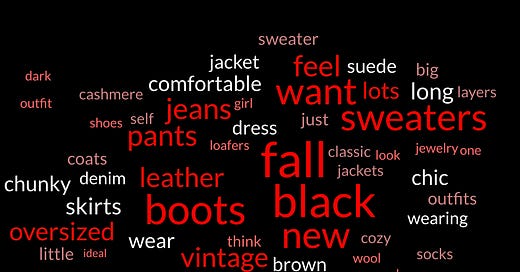


Thanks for this post. I’m a fed who was part of the hundreds of thousands illegally fired. It’s not easy to get the perspective that you pull together, and I appreciate hearing from business owners. My family has dramatically reduced our spending and will continue to do so.
This was a great round-up on the actual impact we're going to see for businesses, but I think what's also interesting is HOW this is going to start to be felt beyond pricing. Yes, items are going to get more expensive, but I'm really curious what some of these brands mean when they say they'll take the brunt of it internally. How are they changing hiring, marketing etc to try to make ends meet in these scenarios? What will be the first sign - will we stop seeing large-scale activations that cost $$? That trickles down to less work for experiential agencies, maybe less freebies going out to influencers/less content for influencers... would love the follow-up to be 'what are you cutting, and in what order?'